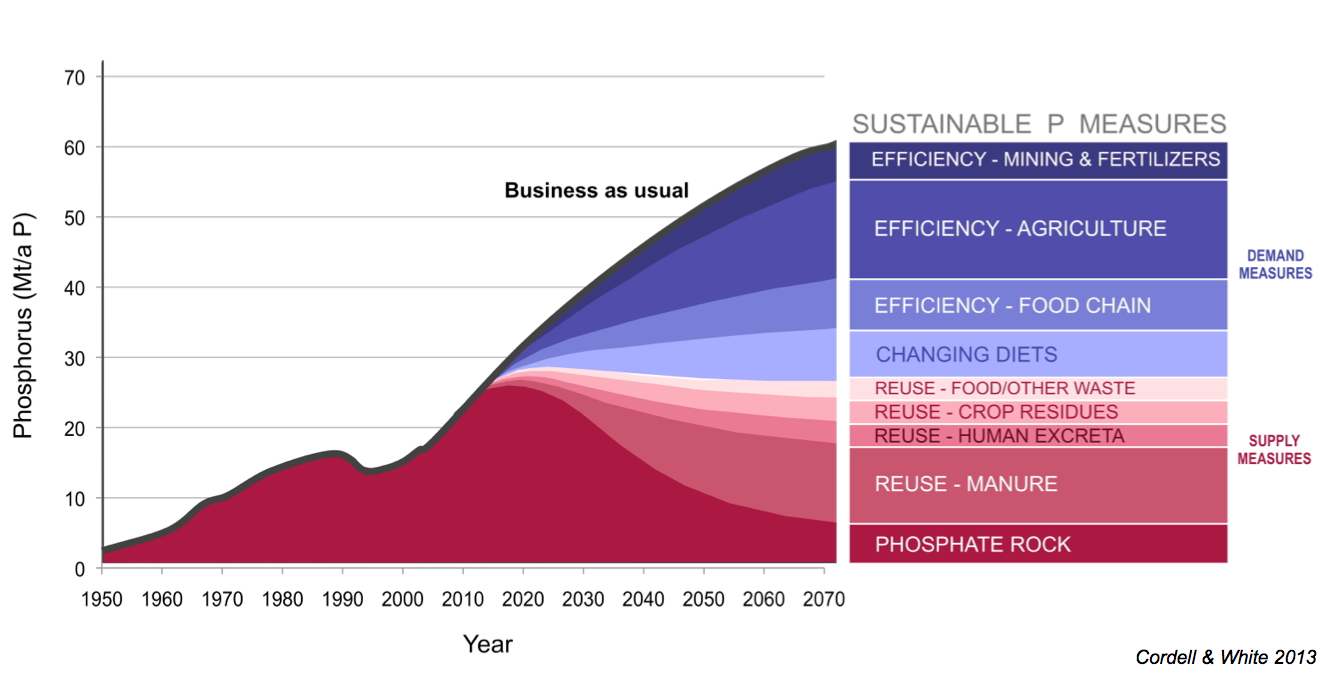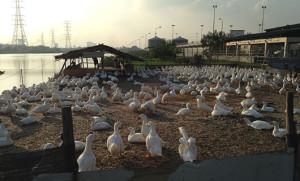Phosphorus Sustainability
The good news is a crisis can be averted. Almost four-fifths of the phosphorus mined for food production never actually reaches the food on our forks: it is lost or waste from mine to field to fork to toilet. To safeguard our farmers, our agriculture and food consumers, we can therefore invest in renewable phosphate fertilisers or innovations in on-farm efficiency. In fact, there is a whole ‘toolbox’ of phosphorus recycling and efficiency measures potentially available in all sectors, ranging from increasing efficient practices in agriculture and mining, to low- or high-tech phosphorus recovery in the sanitation sector to changing diets.

However like other complex or wicked sustainability challenges, there is no single solution. Developing and implementing practical solutions to meeting long-term future phosphorus demand will involve substantial technical and institutional challenges. Key will be taking an integrated, context-specific approach that identifies areas of greatest leverage, to avoid investing in ineffective or partial measures. Technologies and practices don’t implement themselves: effective policy instruments (regulatory, economic, facilitation) are required to stimulate and support such measures
Food Security
“Addressing hunger and under-nutrition is a moral issue, but it also makes economic sense
…For every dollar invested in addressing under-nutrition or hunger, we have a $30 return”
– IFPRI Director General, Dr Shenggen Fan.
 Food demand is on the rise globally with no slowing down in sight. More demand for meat and dairy, especially in China and other rapidly growing economies, means more demand for fertilizers. While our bodies only need around 0.4 kg of P each year, we are mining 22.5 kg of phosphate rock for each person’s diet.
Food demand is on the rise globally with no slowing down in sight. More demand for meat and dairy, especially in China and other rapidly growing economies, means more demand for fertilizers. While our bodies only need around 0.4 kg of P each year, we are mining 22.5 kg of phosphate rock for each person’s diet.
Water and energy are now considered critical for meeting future food demand of a growing population. However there is little or no mention of future phosphorus scarcity as a key factor limiting future food security. Yet without phosphorus, there would be no food, or any life on earth.
There is currently no single international body responsible for managing global P resources in the long-term, unlike oil, water and nitrogen.
Phosphorus recovery
Unlike oil, which is lost once it is used, phosphorus can be recovered and used over and over again if present in sufficient concentrations. Between the phosphate rock mine and the food in our stomachs, up to 80% of P is lost in the process from fertilizer production, application on fields, uptake by crops, food processing and retailing and final consumption.
This tells us that in addition to increasing efficiency in the entire process we can look for opportunities to increase recovery of P in crop residues, food waste in supermarket dumpsters and household bins, manure, human excreta, struvite and other sources such as bone meal, ash and algae.
A key opportunity to meeting the goal of global food security lies in the often overlooked link between addressing hunger and sanitation. Phosphorus (P) is a critical nutrient input in agriculture and its global reserves are being rapidly depleted. It is also a constant nutrient stream in sewage emerging from human settlements that is often considered an environmental pollutant.
Each year, we produce 3 million tonnes of P in our urine and faeces globally. If displaced nutrients (like P) are recirculated back to agriculture from where they first came, we can sustain food production into the future and decouple communities’ dependence on globalised and increasingly inaccessible P fertilizer markets.
Further reading:
Cordell, D. & White, S. (2013) Sustainable Phosphorus Measures: Strategies and Technologies for Achieving Phosphorus Security. Agronomy, 2013, 3(1), p.86-116. http://www.mdpi.com/2073-4395/3/1/86
Cordell, D. & White, S (2014), Life’s bottleneck: sustaining the world’s phosphorus for a food secure future, Annual Review of Environment and Resources, Vol. 39:161-188, http://www.annualreviews.org/doi/abs/10.1146/annurev-environ-010213-113300
Metson, G., Smith, V., Cordell, D., Vaccari, D., Elser, J. & Bennett, E. (2015) Phosphorus is a key component of the resource demands for meat, eggs, and dairy production in the United States,PNAS, Proceedings of the National Academy of Sciences of the United States of America, vol. 111, no. 46, pp. E4906-E4907.
